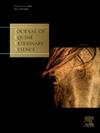Increasing stallion sperm membrane cholesterol improves cold shock resistance and cryosurvival of stallion sperm
IF 1.3
3区 农林科学
Q2 VETERINARY SCIENCES
引用次数: 0
Abstract
Membrane cholesterol levels affect the fluidity and stability of membranes, particularly when membranes are cooled. Sperm from species resistant to cold shock (human and rabbit sperm) typically have higher cholesterol-to-phospholipid ratios (0.88-0.99) compared to the ratios (0.38-0.45) of sperm that are sensitive to cold shock (stallion, bull and ram sperm; Darin-Bennet and White, Cryobiology. 1977; 14:466-470). Cholesterol-loaded-cyclodextrins (CLC) have been used to increase the cryosurvival rates of sperm from many species, however, little is known regarding whether a unique cholesterol/phospholipid ratio is required to ameliorate cold shock and freezing damage or if adding cholesterol alone is sufficient to eliminate this damage. Two experiments were conducted to determine how much cholesterol must be added to stallion sperm in order for them to survive cold shock and to survive cryopreservation. Stallion sperm were centrifuged, the pellet resuspended in modified Whitten's medium (MW) and split into 8 fractions. Each fraction was then treated with 0, 0.2, 0.4, 0.8, 1.0, 1.2, 1.4 or 1.8 mg CLC for 10 min. In Experiment 1, the samples were plunged in ice water (0°C) for 30 min before assessing motility, for cold shock damage. In Experiment 2, the same treatments were split into two groups: one was frozen in MW with glycerol (N=6), and one frozen in lactose EDTA (LEDTA) extender (N=10) and the post-thaw motility evaluated for each treatment. After cold shock (experiment 1) control sperm exhibited lower motility (8%) than sperm treated with any level of CLC (39-59%; P<0.05). In experiment 2, sperm treated with >1mg CLC showed a trend towards higher post-thaw motility over control sperm, after sperm were frozen in MW (30% vs 10%; P<0.05) or LEDTA (62% vs 42%; P>0.05). Cells frozen in MW exhibited lower percentages of motile sperm (17-27%) than sperm frozen in LEDTA (44-48% P<0.05) when treated with 0 or 0.2mg CLC. Sperm treated with ≥ 0.4mg CLC exhibited similar motility, whether frozen in MW or LEDTA, although cells frozen in MW tended to have lower motility (P>0.05). In conclusion when cholesterol is sufficiently high in stallion sperm membranes, cold shock damage can be eliminated, however egg yolk appears to provide additional cryoprotection to sperm than CLC's alone, especially at low CLC levels. Potential sources of cell damage during cryopreservation include more than just membrane damage, as cryopreservation induces osmotic changes that affect sperm volume, as well as damage to the cytoskeleton, and mitochondria, that CLC do not interact with.
求助全文
约1分钟内获得全文
求助全文
来源期刊

Journal of Equine Veterinary Science
农林科学-兽医学
CiteScore
2.70
自引率
7.70%
发文量
249
审稿时长
77 days
期刊介绍:
Journal of Equine Veterinary Science (JEVS) is an international publication designed for the practicing equine veterinarian, equine researcher, and other equine health care specialist. Published monthly, each issue of JEVS includes original research, reviews, case reports, short communications, and clinical techniques from leaders in the equine veterinary field, covering such topics as laminitis, reproduction, infectious disease, parasitology, behavior, podology, internal medicine, surgery and nutrition.
 求助内容:
求助内容: 应助结果提醒方式:
应助结果提醒方式:


